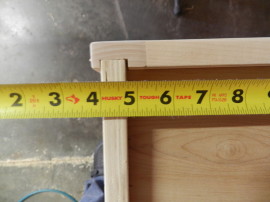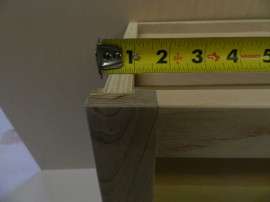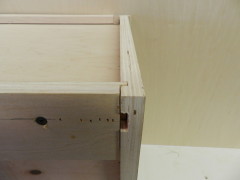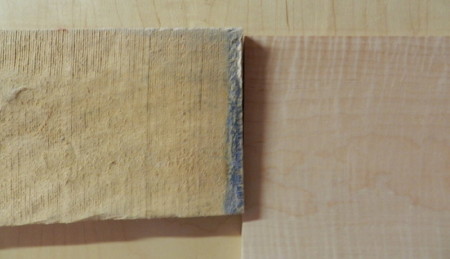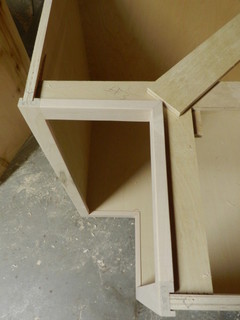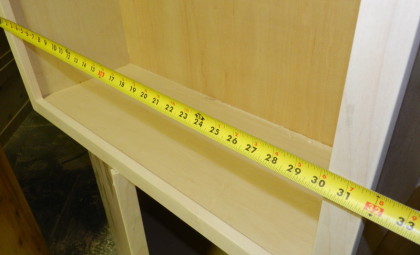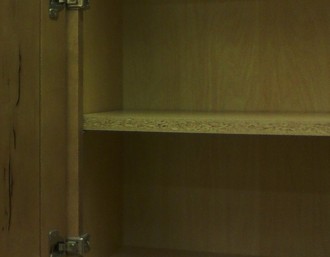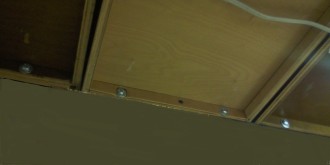Manufacture
What We Offer
Valued Customer,
1:Very important: the box.
Must be built out of ¾” plywood. Most cabinet makers will tell you that 1/2” or even 3/8” is adequate, but 1/2" plywood cabinets next to refrigerators, dishwashers or other appliances that produce heat will warp. The warping will affect the hardware and/or shelves in these cabinets. This is why manufacturers of appliances recommend “clearances” around ovens and refrigerators. Refrigerators being the ones that produce the most heat.
Dishwashers both produce heat and release steam through peep holes, usually located towards the front of the unit. This moisture, without a doubt, will destroy particle board cabinet boxes and doors as well as MDF core doors that are laminated with a sheet using “heat”, known as a thermofoil process.
In the last month alone I have seen two unfortunate examples of this damage. The first kitchen customer decided to remodel completely, however the other kitchen already had granite over their cabinets. The right side and bottom panel of the sink cabinet, next to dishwasher was totally destroyed. We repaired the side panel so that door could be re-hinged. The granite above this sink was 2 years old, so now they run the risk of damaging $1200.00 worth of granite. Removing a top that is fragile and has been glued to the wall and cabinet box with epoxy is very difficult.
The strength of the plywood is also very important if you’re installing granite, the total weight of your granite countertop can easily weigh in excess of 1000 pounds. Properly engineered 1/2” plywood will hold the weight but if affected by heat, moisture or water, it will warp and affect the granite as well. Again, although 1/2” plywood can be engineered to hold the weight of granite, the cabinet box itself must be built properly. I have seen poorly built cabinet boxes completely collapse under the weight of granite.
2: The type of plywood.
The plywood we use is at least 9 plies (not including the exterior veneers) and 3/4” thick. It is stainable on the inside and outside of the cabinet. A natural finish on the inside stands up to scratches better. The outside is stained to match the doors. We also stain and finish the bottom of the wall cabinets. There’s nothing worse than sitting in your family room and seeing a natural color stain under all your wall cabinets or worse, seeing a “made to look like a natural finish using a plastic film”. Even if your cabinets have a light stain on doors and the outside, this natural look under your wall cabinets is noticeable, so imagine if your cabinets are dark, like cherry, walnut or mahogany. Most cabinet manufacturers, even the big names, laminate the bottom with a paper thin natural color film laminate due to a manufacturing convenience and cost. Manufacturers that do use plywood with a natural wood veneer for the inside of a cabinet will use an inferior grade plywood that very often does not match the exterior grain of cabinets or the doors. The grade for plywood should be “B” or better. You don’t have to go far to see a lower grade birch plywood inside “TOP OF THE LINE” cherry cabinets.
*Most of the plywood that’s imported from China comes with a thinner veneer. It’s cheaper to buy and because of the lower quality, the veneer bubbles up when stained and it quickly wears down when sanded in the finishing process.
3. How box and face frame are put together.
The cabinet boxes we manufacture are face-framed with 1 ½” wide solid wood. This is important to give box strength. A common problem with “European” style cabinets is the lack of a face frame. Have you ever turned a shelf upside down because it has sagged under the weight of plates or canned goods? I’m sure most of us have. This is fine for a shelf that's not made of particle board and is less than 27 inches wide. Now imagine the same thing happening to the bottom panel of your wall cabinets, there’s no flipping this part of the cabinet. Once it has sagged it will remain that way. All of our custom cabinets are built with a face frame so that you don't have to "LIVE" with the shortcomings of a poorly designed cabinet.
The face frame is dadoed / notched on the backside. Allowing the plywood box to fit in this dado (groove) on back side of face frame. This union is glued, nailed and screwed. I’ve often seen cabinets that are sold as face frame cabinets but face frame is attached to plywood box with snap on clips. You can literally pull the face frame right off the plywood box with just a gentle tug. The assembly process is just as important as the materials we use. Every cabinet we build is inspected by me the owner.
4. The Nailing Board.
The nailing board on the backside of cabinets that goes against the wall at the top and bottom that hold your cabinet and everything in it should be 3/4” thick. This board should be screwed from the backside to the plywood box itself for strength with 150# screws.(meaning each screw is able to hold 150 lbs). I just recently repaired a wall and cabinet that fell right off the wall, part of the nailing board was still on the wall but cabinet box fell off and damaged all the contents and countertop. Fortunately for the owners, no one was standing under the 3 cabinets when they came down and the glass doors did not harm anyone. They could not get the original cabinet maker to do the repairs and they asked us to repair the damages. I had originally given the homeowner an estimate but a fast talker convinced them to go with a “more economic product”.
5: The grade of solid wood.
Grade for the doors should be “FAS -1F” on at least one side and “#1” on the other. #2 has too many knots. If a cabinet maker does not know what this means than they are not familiar with the product they are selling you and more than likely not building but getting the cabinets from a factory that mass produces them. We purchase all our hardwoods in a more raw state allowing us to obtain them at a lower price. We then plane them to the proper thickness for use on doors, face frames on cabinet boxes and any trim work such as crown molding, chair rail, etc.
The picture above shows a planed down smoother piece of wood next to one untouched.
Also ask your cabinet maker what was the moisture content of the raw lumber when purchased. They should be able to tell you it's about 8% here in the state of Florida.
6: The hardware.
All the hardware should be either “Mepla” “Blum” or “Grass” just to name a few. That would be the hardware for doors, drawers and pullout shelves. Using a lower grade will degrade within a couple of years. You’ll notice this when your doors no longer have that spring to close on their own. This is especially important with the hardware on the “soft close” drawers. Under-mounted soft-close hardware is used on all drawers and hidden under-mounted guides (upon request) or "Mepla" side mounted guides on all pullout shelves.
The hardware we use for trash or condiment pullouts is the ball bearing type which is very durable and mostly used for commercial applications. The reason for this is because these are used at least 15 to 20 times every day. The most widely used trash bin hardware, which is made of a coated wire or chrome frame will also go out of adjustment often. We make the frame out of wood which is a lot more durable for the same cost and will rarely need any adjustment. Wood is also more “custom” than a metallic wire frame.
6: The Clear Coat.
The finish/clear coat I use is resistant to household chemicals and some stuff you wouldn’t think of using around the house like gasoline, kerosene, etc.
A list of the chemicals is available upon request.
7: Custom work.
A tell-tale sign of a cabinet maker that does not manufacture the cabinets is the word “fillers”. While they go over their plan on how they think your kitchen should look, they casually start filling in the voids with fillers. They tell you "these are the pieces of wood that go between the cabinet and the wall or another cabinet because cabinets come in standard sizes so we need to put in a 2 inch filler”. Another is the blind corner cabinet, this is the cabinet where you put in the items you will no longer use for the next 10 years or the items you do use but have to dig them out every time you use them. In my 25 years in the business I have yet to build a blind corner cabinet. The picture above is of a "lazy susan" corner base cabinet that is not your typical size. If a cabinet maker tells you there’s no way around it, they’re not trying hard enough or are inexperienced.
Another word I have an issue with is “standard”. The wall cabinet above is 31 3/4 inches wide, 32 inches would have been too wide and 30 inches would have required a 1-3/4 inch filler. So unless they’re talking about the size of a stove, cooktop or a refrigerator which come in defined sizes, the words “these cabinets only come in a standard size” should never be heard. Using the word “standard” when it comes to cabinets is the same as admitting to being limited to what one can do. We will build your kitchen as if it were going to be installed in our own home and most important it has our name attached to it.
What our Competitors Offer
These are some examples of our competitors. To the right you can see a particle board shelf. It would be fine if all cabinets were 18" and under and were not placing heavy objects in them like a pile of dishes or canned goods, but then again that's what cabinets are made for. Particle board shelves on wider cabinets will eventually start to sag, you can flip them over and over but unfortunately it'll be a matter of time before they break.
Below is an example of particle board used on the side panels and bottom panels of wall cabinets. You can see how wide the panel is (about 3/8") by looking at the electrical wire coming from the light. If 3/8" thick particle board is being used for wall cabinets then you can be sure it's also being used for the base cabinets.
This next picture to the right is a perfect example of how some "top of the line" wall cabinets are finished underneath. You can see the panels are fairly good quality plywood but the same manufacturer has some cabinets stained and some not. You can also see how the stained cabinet to the right is lighter than the one on the left. The last thing would be the end grain of the side panels were left in a raw state. In my opinion the bottom of all these wall cabinets should be stained and finished completely and uniform.
I hope this information is useful when considering us or another cabinet maker to do your next project.
Sincerely,
Alex Baez
Owner



